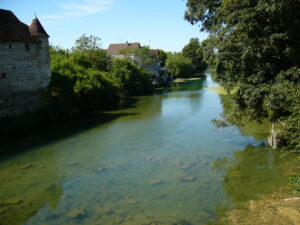Chablis
 Although Chablis can be reached from Beaune after some one hour trip on the A6 its not on our road to Burgundy or Southern France. For the same reason we have not yet been regular customers here. Another important reason being, that major diversity exists as the styles of Chablis available and consumers need to identify what style of Chablis they prefer!
Although Chablis can be reached from Beaune after some one hour trip on the A6 its not on our road to Burgundy or Southern France. For the same reason we have not yet been regular customers here. Another important reason being, that major diversity exists as the styles of Chablis available and consumers need to identify what style of Chablis they prefer!
The consequences of decisions made by INAO in 1976 removing the reference to Chablis should be grown on a subsoil of Kimmeridgian limestone and taking into account all factors, including microclimate, for classification, expanded greatly the PC and Chablis area and many of the new vineyards are claimed dubious. Add to this that several subparcels can be included in a well know PC ie. the PC of Vaupulent, Côte de Fontenay, Vaulorent and l’Homme Mort can be included in Fourchaume. It is hard to understand the rationale behind imposing less known PC on flagship PC. Finally, crop yields, the use of oak barrels for fermentation or aging, and the degree to which the wine is processed highly influence the individual styles of wine. The seven GC all lie on the north/right bank of the Serein River, sitting on the richest Kimmeridgian limestone soil. On the north bank you also find the best PC. The production from these sloping hillsides often turns out the finest and most dependable wines. Compared to the white burgundies from Côte d’Or, they are more acidic with a characteristic steely mineral content and distinctive flavor.
Within the family, we do not fully agree on style, some of us like Chablis that is fermented and aged in stainless steel, while others like barrel-fermented and oak-aged Chablis. However, we all agree that the following domains are highly recommendable and their wines fairly priced: Domaine Jean-Claude Bessin; Domaine Corinne et Jean-Pierre Grossot